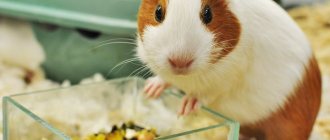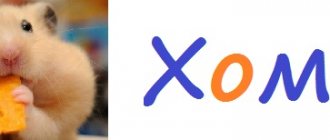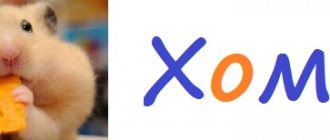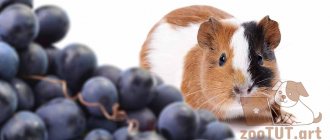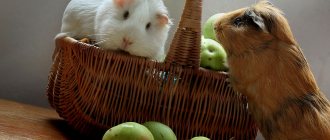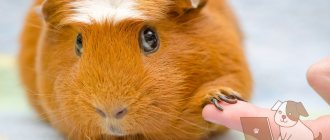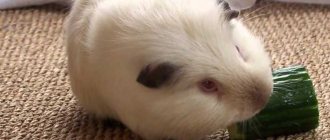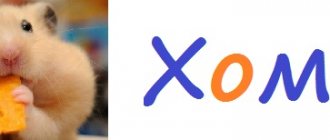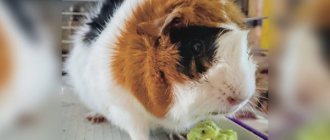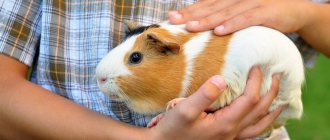- home
- Guinea pig
- Guinea pig nutrition
03/12/2019 Guinea pigs are unpretentious animals, but their diet also requires balance. Only the correct ratio of vitamins and microelements can support the health of pets. Due to the long digestive tract, this type of rodent needs plant fiber, which vegetables will help to obtain. In the autumn-winter period, when the animal’s body needs additional nutrients, veterinarians recommend giving beets to the guinea pig. How is it useful for animals?
Can guinea pigs eat beets?
Yes, guinea pigs can definitely eat beets.
Beets are an excellent source of fiber, potassium, vitamins and folic acid, which our guinea pigs need. However, it also contains decent amounts of calcium and phosphorus, which can be harmful if overfed. Therefore, moderate serving is recommended.
Beets are one of the healthiest vegetables you can feed your guinea pigs. But there are some nutrients in beets that are harmful to our guinea pigs. However, periodic feeding may do more good than harm.
Effect on the body of animals during feeding
Cows
Cows eat fodder beets with great pleasure.
When it is introduced into an animal’s diet, milk yield increases significantly. The amount of root vegetables consumed should not exceed 18 kilograms per day. This norm is calculated for an adult animal.
15 days before calving, you need to stop feeding fodder beets.
Goats
Root vegetables contain a substance that normalizes fat metabolism and also improves digestion.
Just like for cows, eating fodder beets by goats helps increase milk production and fat content. For an adult goat weighing 55–70 kilograms, it is enough to feed 3–4 kilograms of vegetables per day.
Chickens
At any time of the year, and especially in winter, birds need to consume plant feed. Eating the fruits and tops of a healthy plant helps compensate for the lack of vitamins in the chicken’s body. As a result, the eggs will have a hard shell and the yolk will have a bright summer yellow color, which indicates the health of the bird.
The amount of beets should be calculated in such a way that there are no more than 30-40 per adult.
Rabbits
Rabbits very actively consume both the beet fruits themselves and its tops. This is a very healthy vegetable, as rabbits need fiber for normal digestion. Eating fodder beets will make the animals' fur look healthy, and the taste of the meat will also improve.
An adult rabbit can consume up to 300 grams of fodder beet without harm to its body.
Important. Beets should be introduced gradually into the diet of animals
To begin with, it is better to feed the rabbits boiled vegetables.
Pigs
The plant is a favorite treat for pigs. They can consume it both raw and boiled.
The result of feeding beets will be very good. Due to the fact that the root vegetable normalizes digestion, the animal’s weight gain will increase. Another useful property of beets is the improvement of fat metabolism, so when an animal eats the vegetable, it can reduce the fat content of meat.
The amount of root vegetables in the diet can reach up to 30 percent of the total food consumed per day.
Fodder beet is an indispensable ingredient in the diet of animals. It has beneficial properties that help them grow healthy and improves the quality of their products.
Are beets safe for guinea pigs?
Yes, beets and beet greens are completely safe for our guinea pigs when fed in moderation. Anything in excess is bad, and the same goes for beets. If we add it in excess, the high calcium and phosphorus content of beets can have a negative impact on our guinea pig's health.
Some of the common health problems that can be caused by overfeeding beets to our guinea pigs are:
Bladder Stone Beets and beet greens contain a decent amount of calcium. If we regularly feed beets to guinea pigs in excess, it can lead to various health problems such as bladder stones and deposits.
Diarrhea: Guinea pigs have a sensitive digestive system and introducing a new food or feeding an excess of a particular vegetable can lead to severe diarrhea in guinea pigs. Sometimes diarrhea can be fatal to our guinea pig's life; So make sure you feed vegetables like beets and greens in the right quantity to avoid such health problems.
Possible negative consequences
If an animal has eaten beets and has a food allergy, the following reactions are possible:
- eye inflammation, lacrimation;
- sneezing, coughing and nasal discharge;
- impaired breathing;
- diarrhea, vomiting;
- the appearance of an itchy rash;
- dizziness.
Reference! The very first thing to do in case of food poisoning is to contact a veterinary clinic. Be sure to avoid further consumption of the allergen. If the symptoms are very strong, then before the doctor arrives, you can give the animal activated charcoal.
Benefits of feeding beets for our guinea pigs?
Beets are one of the healthiest salads or vegetables in the world. It has many benefits for our guinea pigs; so you can add some into their diet. If beets are fed in the right quantity, they can be really beneficial for our guinea pigs.
Here are some of the most common benefits of feeding beets to guinea pigs:
Source of Vitamins: Beets and beet greens are an excellent source of some rare vitamins and minerals, including vitamin B1, B2, B3, B4, B5, B6, vitamin C and more. These vitamins are essential for a healthy life for our guinea pigs.
Prevents Diseases: The antioxidants and vitamins found in beets and beet leaves can help prevent various diseases in guinea pigs. It can prevent urinary tract infections, cancer, and several other serious diseases in guinea pigs.
Anti-cancer properties: A group of antioxidants called betalain has been shown to have anti-cancer properties. Although cancer is not a common disease diagnosed in guinea pigs, they can still develop tumors that can develop into cancer at a later stage if left unchecked. Thus, adding such food can help prevent any similar circumstances in the future.
Proper Body Function: Guinea pigs require a variety of nutrients added to their diet for the proper functioning of their body. Beets are rich in a wide range of nutrients that our guinea pigs need, so adding some beets to their diet can help provide them with the nutrients they need.
Where to collect and how to properly process herbs
Grass for guinea pigs should be collected exclusively in clean areas, away from landfills, garbage cans, busy highways, and industrial facilities. Do not store grass and tree cuttings where dogs are walked or livestock is grazed.
Near fields and vegetable gardens, where plots are often fertilized with pesticides and nitrates, it is also prohibited to collect greens for pets. In places where there are a large number of trees (forest, grove, park), stocking up on food is also not worth it, since ticks may accumulate there. The grass should be picked in an open meadow, away from all possible sources of pollution.
How many beets can guinea pigs eat?
You can feed your guinea pigs one small piece of beets right away. Never go beyond one slice as overfeeding beets is not ideal for our guinea pigs.
To ensure that your guinea pigs receive a well-balanced diet, you need to mix at least 4-5 healthy vegetables.
It is ideal to mix two leafy vegetables such as lettuce, kale, spinach, cilantro, parsley with other vegetables such as tomatoes, green beans, cauliflower, bell peppers, carrots, etc.
How to replace radishes
Despite the obvious limitations in feeding radishes to a guinea pig, similar products can be found. In general, pet stores offer a wide range of ready-made dry food for rodents, but many owners prefer to feed their pets themselves. Therefore, you should immediately find out which products are suitable for feeding the animal:
- Spinach;
- Cucumbers;
- Tomatoes (in limited quantities);
- Sweet bell pepper;
- Carrots (can be given on a daily basis);
- Parsley leaves;
- In summer, you can offer your pet thoroughly washed dandelion leaves;
- Fruits and cereals.
Despite the obvious simplicity of feeding, each product has its own dosages and recommendations; you can familiarize yourself with them, but it would be better to use a ready-made mixture purchased at a pet store.
Turnips or radishes can be used as a substitute for radishes; they have a similar taste and aroma, but cannot harm the fragile body.
Can hamsters eat beets?
The root vegetable contains many useful microelements. Feed rodents with caution. Try giving your baby a tiny piece of this vegetable and see his reaction. If everything is fine with his stool, you can give him a larger piece.
Do not overuse the size of the slice - it should be no larger than a button. If you overdo it, your pet will develop diarrhea, and small animals do not tolerate gastrointestinal diseases well.
What factors should you consider when introducing cabbage into your diet?
Cabbage is a good food that helps expand the diet of a herbivorous rodent. If you follow simple rules, cabbage can be introduced into your diet without any difficulties:
- If bloating or intestinal problems occur frequently in an animal, it is necessary to give up the vegetable. The order in which such a fluffy eats food needs to be reconsidered, in addition to organizing a visit to a specialist and taking tests.
- When introducing the product into the feed for the first time, only a portion should be given. If normal tolerance is detected, gradually increase the amount. Experts in pig breeding also remind that cabbage is not a complete food and does not need to be included in the diet every day; it must be given together with other food in parts, no more than once during the day.
- For better absorption, first put the cabbage in the refrigerator for several days.
- External foliage must be removed before use. The kohlrabi variety of cabbage is peeled, while other types are washed. Cabbage for a pet must be prepared so that the person himself wants to eat it. Waste is not the best food for your pet.
- The rodent must have a healthy diet, in addition to this, it needs to move and run a lot in order for the natural normal functioning of the intestines to take place.
The sea rodent has a thin stomach and long intestines. Its digestion works normally with systematic consumption of food and intake of the required amount of fiber.
A proper diet is a guarantee of your pet's well-being. Therefore, you should not experiment with it. Follow the correct diet and order of food intake, and you will get a healthy and strong fluffy.
What I am a master at is talking incessantly about hamsters. I have three hamsters at home, and my husband has a pet rat. That’s how we live, the six of us eat, the six of us sleep :)
about peeling vegetables
about peeling vegetables ¶
From: Lumen - August 29, 2011 7:14 pm
Good afternoon Recently this stupid question came to my mind... or maybe not stupid, depending on how you look at it
